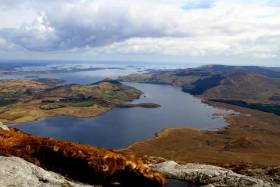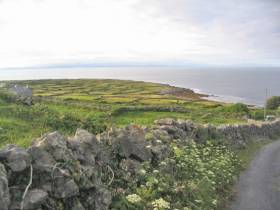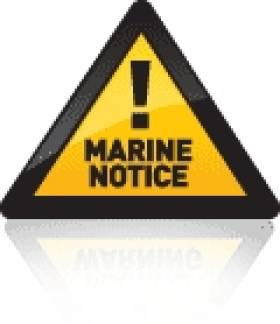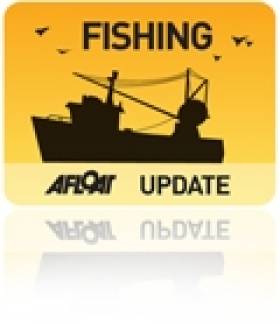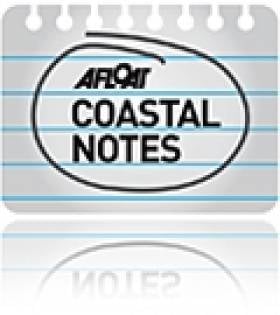Displaying items by tag: Corrib
A multi-agency group warns that lives of rescuers on Galway’s river Corrib are being put at risk by salmon and eel traps on a city stretch below the Salmon Weir.
As The Sunday Independent report, Galway’s chief fire officer Gerry O’Malley has said the structures owned by Inland Fisheries Ireland (IFI) pose “significant risk” to his staff.
The structures associated with a salmon pass known as “The Queen’s Gap” and eel traps are out of bounds now to Galway Fire and Rescue Service crew.
A person caught in the fast flow in that area could die from impact, or could drown if caught in or pinned to one of the rails stretching across the river, O’Malley warns.
A body of a missing person, which was found in the river, had been trapped in the rails of one of the structures for almost three weeks, according to Galway City councillor and chair of the Claddagh Watch river patrol group Niall McNelis (Lab).
McNelis, who participates in the Inter-Agency Corrib Water Safety Group on behalf of Claddagh Watch, has tabled a motion on the issue for a city council meeting tomorrow (Mon, July 10).
“This is an issue of general safety for anyone on or near the river, but also the safety of rescuers,” RNLI lifeboat operations manager Mike Swan, also on the inter-agency group, says.
That safety risk came into very sharp focus in January of this year, when up to ten people were rescued after three rowing boats attached to the University of Galway and to Coláiste Iognaid secondary school capsized when the river was in flood.
“Several of the boats were caught at the top of the Salmon Weir. If any of those crew had been swept over the weir, they would not have survived the Queen’s Gap,” Swan confirmed.
Galway Fire and Rescue crews responded to 29 water rescue incidents in 2020, 57 in 2021 and 29 last year, most of which were on the river Corrib. The crews have responded to 18 separate water incidents, also mainly on the Corrib, this year to date.
IFI says the structures are “listed”, and it is “in ongoing discussions with Galway City Council to best understand how to manage these structures into the future”.
Read more in The Sunday Independent here
Longest Day Swim Returns to River Corrib this Weekend
The “Longest Day Swim” on Galway’s river Corrib takes place this Saturday after a two–year break due to Covid-19.
North American Olympic gold medallist Joseph “Gunnar” Bentz has been invited to lead the event on July 2nd.
Bentz won two gold and two bronze medals at the FINA World Junior swimming championships, and holds silver and bronze medals from the Pan American Games.
Two courses – four km and 2.5km – have been set from Glenlo Abbey and Dangan, with both finishing at Steamer’s quay, Woodquay, in Galway city.
Galway Swimming Club (GSC) is hosting the event, with funds going to the young people’s mental health charity, Jigsaw.
The timed river swim is open to competent open water swimmers who must be over 18, and must be members of Swim Ireland for insurance purposes.
. “We’re delighted to bring back the Longest Day Swim and to promote the physical and mental health benefits of swimming,” GSC chairman Mark Gibbs has said.
“I’m particularly happy to welcome Jigsaw on board as our charity of choice this year.”
Places are said to be “filling up fast” and more details are here
Corrib Beo Community Partnership Hosts First TY "Ecoadvocates" Field Trip in the West
Community partnership Corrib Beo has initiated a series of educational field trips as part of its mission to promote the sustainable development of the Lough Corrib catchment in the west.
Transition year (TY) students from Coláiste Iognáid participated in the first such field trip with architect, environmentalist and broadcaster Duncan Stewart.
The TY course, named Eco Advocates, is an initiative of EcoEd4All, the environmental pillar of Corrib Beo.
Corrib Beo is a coalition of communities, environmentalists and voluntary groups dedicated to the care protection and sustainable development of the Corrib, its catchment landscapes, rivers and canals.
During the first field trip, the Coláiste Iognáid students joined Stewart and Eco Advocate course leader Jen Cunningham on the banks of the waterway, where Stewart discussed the importance of engaging with the key environmental themes of biodiversity, climate change, circular economy and water/air Pollution.
A water quality sampling session was led by Galway-Mayo Institute of Technology marine biology students, Molly Curran and Joseph Donnelly.
Galway National City Park founder Brendan ‘Speedie’ Smith, who is a committee member and content contributor to EcoEd4All, also spoke to students about the importance of the circular economy and the Galway National Park City initiative.
All school enquiries for TY bookings on the EcoAdvocate scheme should email [email protected] or phone 087 7660818.
Oscar Wilde’s surgeon dad waxed lyrical about it, Vikings lost their weapons in it, and poitín makers and anglers have shared their knowledge of its rocks and islands.
The Corrib – this island’s second largest lake after Lough Neagh – is also host for the Cong-Galway yacht race, which is said to be Europe’s oldest contest of its type.
Game anglers are well familiar with the Corrib, but the catchment could also be Ireland’s Cumbria, a new group says.
The Corrib Beo catchment partnership, which is holding its first conference later this week in Galway (May 2), describes itself as a “coalition of activists and interest groups” which aims to realise a new “shared vision” for the freshwater environment.
It aims to develop a 25-year plan for the entire system extending from Cong and Lisloughrey to Galway city.
“The Wild Atlantic Way is attracting record numbers, but those same visitors attracted to the coastline should know that the Corrib is the pendant on that necklace,” Corrib Beo co-founder Denis Goggin, says.
The Corrib is a special area of conservation, and surgeon Sir William Wilde was author of its best-known history, Lough Corrib: Its Shores and Islands, published in 1867.
A 4,500-year-old log boat was among 12 early Bronze Age, Iron Age and medieval craft and several Viking-style battle axes discovered over five years ago by marine surveyor Capt Trevor Northage during his work to update the charts of the lake.
The 44 km-long waterway is managed by a number of State agencies and the two local authorities in Galway and Mayo. The lake rich in wildlife faces constant pressures from pollution and invasive species, such as the curly waterweed, Lagarosiphon Major, which Inland Fisheries Ireland has been tackling.
The Corrib Navigation Trustees, who report to Galway City Council, are responsible for maintenance of navigation aids, piers, the Eglinton canal system and associated walkways and lock gates.
Irish walkers are well familiar with the quartzite Maaumturks and the Maaumtrasna and Partry mountains which provide the backdrop to its limestone pavements, along with the bog-carpeted granite of south Connemara.
However, its potential does not have the international caches of Cumbria and the Lake District which attracted over 47 million visitors in 2017, according to Mr Goggin.
The region, embracing England’s highest mountains and the Lake District national park, employed over 38,000 people and generated £2.9 billion sterling to the region's economy according to 2017 figures issued by Cumbria Tourism.
“We are not saying we want the Corrib system overrun by international visitors in the way the Lake District can be, but there is scope for further sustainable development,” Mr Goggin said.
“The lake has several peripheral areas suffering from depopulation which could do with a boost,” he explains.
“Recently, a few of us travelled north to learn more about the Belfast Agenda, the community plan for Belfast which takes a partnership approach,” Mr Goggin says.
“All of the agencies and community groups are working there towards a common theme to transform one of the British empire’s largest industrial bases into a tourist venue, and we need to take a collective approach towards the Corrib here,” he says.
“The Corrib system is like an orchestra, with three different strands of economy, community and environment being like its wind, percussion and string instruments,” Mr Goggin says.
“The challenges presented in planning for the care, protection and sustainable development of the Corrib are a microcosm of the greater humanitarian and environmental challenges of our age,” the Corrib Beo group says.
“ However, the timing of this new initiative to address these challenges has never been more favourable in terms of the supports available at European, national and local level,” it says, and there is “much community goodwill”.
Corrib Beo is hosting its first conference on May 2nd in Galway’s Commercial Boat Club on Steamers’ Quay, and such is the interest that places are almost booked out already.
Former Environmental Protection Agency director Dr Micheál Ó Cinnéide will chair the day-long event, and speakers will include environmentalists Duncan Stewart and Brendan Smith.
Representatives from many different groups who are “already involved and interested in the protection and development of the Corrib waterways”, will also participate.
Aran Islands Cable Repairs Under Way Weeks After Power Outage
#MarineNotice - Repair works are currently ongoing on the Inis Mór–Inis Meáin cable weeks after a fault left the Aran Islands without power for a number of days.
The works, which began last Saturday 10 September and will continue for another week, weather permitting, are being carried out from an offshore platform manoeuvred with the assistance of workboats, as detailed in Marine Notice No 39 of 2016.
The tug ABBE is also operational in the vicinity of the platform during the repairs. Both platform and tug vessel maintain a listening watch on VHF Channels 12 and 16 for the duration of the project.
The platform is displaying day shapes and night lights as required in accordance with the International Regulations for Prevention of Collisions at Sea (COLREGS).
All vessels, particularly those engaged in fishing, are requested to give the area a wide berth and keep a sharp lookout in the relevant areas.
Another recent Marine Notice advises of a programme of maintenance and inspection on the Corrib subsea facilities from this week for the next three week.
Marine Notice No 38 of 2016 says the work will all take place within the 500m Safety Zone and will involve carrying out a programme of maintenance to investigate and repair some of
the subsea facilities as required.
The support vessel Olympic Ares will carry out the maintenance and inspection using a remote operated vehicle or ROV. The vessel will be listening on VHF Channel 16 throughout the project.
#MarineNotice - Marine Notice No 21 of 2015 from the Department of Transport, Tourism and Sport (DTTAS) advises that Shell E&P Ireland Ltd will be deploying a waverider buoy in late May 2015, weather permitting, in order to help predict sea conditions for the Corrib P2 well intervention work by the Ocean Guardian (Callsign V7FF7).
The buoy size is 90cm in diameter, and is set to be deployed at co-ordinates 54°19.285’N, 011°05.544’W (WGS84) approximate, with a 100m watch circle. The water depth at this location is 336 metres.
The waverider buoy will remain on site for approximately three months. Pictured here, it is yellow in colour and will flash yellow five times every 20 seconds.
All vessels are requested to give the waverider buoy a wide berth.
Two Men Convicted for Illegal Fishing on Lough Corrib
#illegalfishing – At a sitting of Galway District Court on Tuesday, 3rd February, Judge Denis McLaughlin convicted two men of illegal fishing, and issued fines and costs totalling €1,850. Michael Gannon of Raleigh Row, Galway City, and Brendan Hardiman, with an address at Mace, Corrandulla, Co. Galway were both in court on charges of the illegal use of a net, and illegal possession of a net in contravention of the 1959 Fisheries Act.
Judge McLaughlin heard evidence that on the night of 6th July 2014, fisheries officers on patrol observed the men in a boat on Lough Corrib setting a net. The men returned to shore and left the scene. At approximately 2 am on the 7th July the men returned to the lake, rowed out and retrieved the net. On return to shore they were challenged by the fisheries officers, and under caution they admitted the offences.
Both men were convicted by Judge McLaughlin on one count, with the second charge taken into account. It was acknowledged that on the night both defendants had been co-operative, had accepted responsibility for their actions and were pleading guilty to the charges. The judge heard that Mr. Hardiman had two previous convictions for similar offences, and he fined Mr. Hardiman €750, with €300 costs. Mr. Gannon was fined €500 with €300 costs.
Inland Fisheries Ireland (IFI) has a confidential hotline number to enable members of the general public to report incidents - 1890 34 74 24 or 1890 FISH 24. This phone line is designed to encourage the reporting of incidents of illegal fishing, water pollution and invasive species.
Minister Grants Foreshore License for Corrib Pipeline
New Minister for the Environment Phil Hogan has signed off on a key foreshore licence to Shell Ireland, paving the way for the completion of the controversial Corrib gas project.
The Irish Times reports that the licence, subject to conditions, consents for the construction of the final 8km section of pipeline linking the Corrib gas field to Shell's onshore terminal at Ballinaboy. Co Mayo.
The scheme already has approval from An Bord Pleanála, and consents approved by former acting energy minister Pat Carey. But An Taisce has sought a judicial review of the planning decision, due before the High Court on Tuesday.
Still required by the developer before any work can begin are a revised emissions licence from the Environmental Protection Agency and a safety permit from the Commission for Energy Regulation under the Petroleum (Exploration and Extraction) Safety Act 2010.
The Irish Times has more on the story HERE.
- Natural Gas
- pipeline
- Corrib
- Corrib Gas field
- Corrib gas pipeline
- Shell Ireland
- Co Mayo
- Ballinaboy
- Minister for the Environment
- Phil Hogan
- Minister for Energy
- Pat Carey
- An Taisce
- An Bord Pleanála
- High Court
- judicial review
- Environmental Protection Agency
- Commission for Energy Regulation
- Petroleum (Exploration and Extraction) Safety Act 2010
Corrib Project is 'Safe' Says Shell
Any potential risk from the Corrib gas pipeline off Ireland's west coast has been "overstated", according to representatives from Shell.
On the final day of the An Bord Pleanála hearing into the final phase of the pipeline, the oil company's senior counsel moved to assure a concerned public that the project was designed to "the highest safety standards".
"No other Irish development proposal has been subject to such an amount of study and surveys over such a period of time,” said Esmonde Keane at the hearing in Belmullet, Co Mayo on 1 October.
The Corrib project involves the development of a gas field west of the Mullet Peninsula, including the construction of a pipeline to the mainland and a coastal processing plant. The mainland phase of the plan has attracted much concern among local residents.
Two opponents of the project, environmental consultant Peter Sweetman and Monica Muller, a local resident, walked out of the hearing in protest over Keane's closing remarks, arguing that they were intended as “a legal submission”.


























